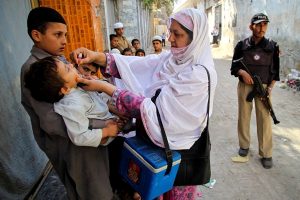Stopping Vaccine-Derived Poliovirus Outbreaks
Knowing how to prevent and respond to outbreaks of polio is the bread and butter of the work of the Global Polio Eradication Initiative, including outbreaks of vaccine derived poliovirus

Any polio outbreak begins in the same way: a child complaining of a headache and a fever. Within just a few hours, the virus causes rapid onset, floppy, paralysis, for which there is no cure. Whether caused by one of the three strains of wild poliovirus (WPV) or by circulating vaccine derived poliovirus (cVDPV), the result of is the same: a lifetime of paralysis that could have been prevented with a simple vaccine.
The Global Polio Eradication Initiative (GPEI) works to stop all types of the virus permanently, to provide a polio-free world for future generations. In 2014 and 2015, cases of paralysis caused by cVDPVs have been reported in Madagascar, Mali, Nigeria, Pakistan, South Sudan and Ukraine. The GPEI responds to children paralysed by cVDPVs just as they would to an outbreak of WPV- with technical support to the country, strengthened and expanded surveillance, community engagement and a rapid, large scale immunization response
A cVDPV is an extremely rare strain of polio genetically changed from its original, weakened strain contained in oral polio vaccine (OPV). Excreted vaccine-viruses can find susceptible children and begin to circulate beyond the immediate household into the broader community, which in the vast majority of cases is a positive thing, spreading the protection of the vaccine further. However, the longer it is allowed to survive this way in areas where not all children are receiving the vaccines, the more genetic changes it undergoes as it replicates, and eventually it can revert to the point that it can cause paralysis. Circulating VDPVs are viruses that have gone through this process. Therefore cVDPVs are the consequence of failure to vaccinate children, rather than of the vaccine itself.
Circulating VDPV events are extremely rare. Over the past 10 years, more than 10 billion doses of OPV have been administered to more than 2.5 billion children, preventing more than 650,000 polio cases every single year. In that same period, only 21 cVDPV episodes are known to have occurred, resulting in 622 cases. But a child paralysed by any polio virus is irrevocably affected for life, and so once wild polioviruses have been successfully eradicated, OPV must be phased out, as the public health benefits of OPV will no longer outweigh the very small risk of its continued use.
If a population is fully immunized, they will be protected against both cVDPVs and WPVs, and the outbreak will be brought to a close.
Trivalent oral polio vaccine (tOPV) has long been the vaccine of choice for routine immunization in many parts of the world – it is the only vaccine for polio that can stop transmission fast enough to stop outbreaks. It was the vaccine that eradicated wild poliovirus type 2, which hasn’t been seen anywhere since 1999, after all. But while wild poliovirus type 2 is gone, 90% of circulating vaccine-derived poliovirus cases are caused by a mutated form of the type 2 component in OPV.
The bivalent oral polio vaccine (bOPV) – which does not contain type 2 – is more effective against the two remaining wild poliovirus types. So the world’s guiding body for vaccination policy, the SAGE or Strategic Advisory Group of Experts on immunization has called for a globally synchronized withdrawal of type 2-containing OPV – necessitating a switch from tOPV to bOPV in routine immunization programmes. In its landmark decision, the SAGE also recommended that all countries introduce at least a single dose of inactivated polio vaccine to mitigate the risks associated with this switch. This switch is currently scheduled for April 2016, a decision that will be reviewed by the SAGE in October.
Stopping the use of OPV over the next few years, starting with tOPV, is the most important step to prevent outbreaks of cVDPV.
The response to outbreaks of all polioviruses take the same steps to increase both immunity and vigilance of the acute flaccid paralysis surveillance system. The partners of the GPEI (UNICEF, WHO, CDC and Rotary International) provide technical support to affected countries as soon as an outbreak is reported to investigate, assess and monitor the outbreak and the response.
Most importantly, any outbreak response ensures that children are reached with multiple rapid, large scale vaccination campaigns that are designed to target the most vulnerable groups.
Well-functioning surveillance systems are important in any country that is vulnerable to poliovirus; and while polio continues to circulate anywhere in the world, any country with levels of immunity lower than 95% of children fall within that category. Once a single case is brought to the attention of the surveillance system, the country puts its network on high alert: surveillance officers visit communities, health care centres, school, traditional healers and any other places they can think of to look for cases of paralysis that could be caused by polio. This ensures that wherever the virus is circulating, it will be found and stopped.
Engaging countries from the most remote communities to governments at the highest level is essential to any outbreak response. Ensuring that governments drive activities and that everyone understands the importance of bringing their children to receive all doses of the vaccines.
If a population is fully immunized, they will be protected against both cVDPVs and WPVs, and the outbreak will be brought to a close. The GPEI will continue to work relentlessly to stop polio transmission everywhere in the world until eradication is achieved.












